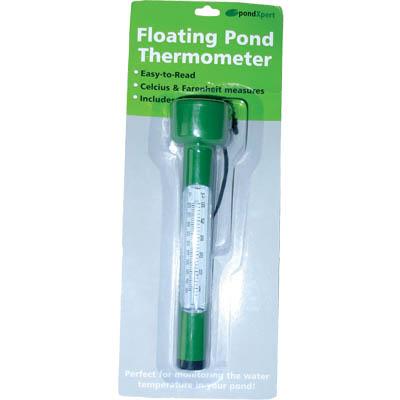Why Temperature plays a big role in Pond Development
Water temperature plays a vital role in the overall health of the eco-system and the health of pond fish. Being aware of the changes throughout the year, while monitoring temperature along the way, will help you keep the temperature within a safe margin for both your fish and for pond maintenance.
What causes the temperature of the pond to change?
As you can imagine, your pond will increase its temperature in the summer and decrease its temperature in the winter. This plays a big role in your fish’s daily lives, as this weather causes something called ‘thermal stratification’. In short, the warmer water will always be on top and the cooler water will always be at the bottom. As the temperature increases and decreases in summer and winter, the water will turn itself over naturally; in winter, the colder surface water will sink to the bottom of the pond, pushing the warmer water to the surface and so forth.

Warmer water will not hold as much oxygen; particularly when the temperature hits 30 degrees C. In short, fish generally need a minimum of 7ppm (parts per million) of dissolved oxygen. On average, ponds will drop down to 8ppm of dissolved oxygen at 25 degrees C. At 30 degrees C, the amount of oxygen can drop to below 5ppm of dissolved oxygen. Because of the decrease in oxygen in the pond, you may see your fish start to go sluggish, as they enter a conservation period. Therefore it is really important to make sure your pond is well aerated throughout the warmer months. You can find more information on how to aerate your pond by looking into our Air Pumps blog section.
Similarly, your fish may enter early hibernation if the temperature is too cold. If the temperature of your water hits 15 degrees C or below, you may see your fish start rest at the bottom of the pond as their metabolism slows down.
Based on the temperature, you will need to feed your fish specific food. While the weather is warmer, you should provide protein-rich food. Whereas in the winter, a diet lower in protein and higher in carbohydrates is more suitable. You can find out more information on this on our Fish Food blog post.
.jpg)
As previously stated, warmer water contains less dissolved oxygen. This can also have an impact on your pond environment (bacteria, plants, wildlife, etc). Less oxygen equates to a harder environment to thrive. If your pond doesn’t have enough oxygen, then you may see your fish and plants dying off; they can then decompose in the pond and drastically affect the chemicals in the pond. To keep your pond from getting too warm, you should try to aim for a 50% coverage in pond plants (Lilies and Floating Plants are excellent at this!) or providing shade through other means.
As the temperature of the pond increases, you may also find that the pH of the water changes. pH is the scientific scale used to specify whether a liquid is alkaline or acidic. Low pH (below 7) is considered acidic, 7 is considered neutral and a high pH (above 7) is considered alkaline. A pond that is too acidic or alkaline will struggle; this is because the healthy bacteria in the pond will struggle to thrive and can cause Ammonia spikes. Regularly testing your pond water with either the Tetra Pond Test 6 in 1 or the Blagdon Pond Health Test Kit will help you to identify whether your pH is too high or low, alongside testing for other chemicals in the pond. You can use our Water Quality blog for more information on the chemicals in your pond.

You should try to keep your pond between 16-25 degrees C as much as you can, as this is a good temperature for fish, plants, and wildlife. Throughout winter, you should try to prevent the water from dropping below 10 degrees C; or at least you should try to prevent the ice from forming on the surface of the pond. If your pond does freeze over during winter, you may find our blog post ‘What to do if your pond freezes over’ useful.
To monitor the temperature of your pond, a PondXpert Floating Pond Thermometer can be used. This handy thermometer sits on the surface of the pond can continuously measures the temperature of the pond.
If you have any queries, please email us on info@pondkeeper.co.uk.